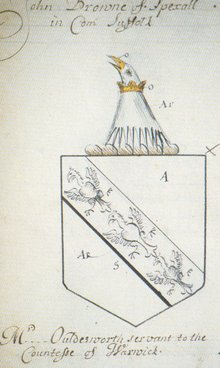Tricking
Tricking is a method for indicating the


Origin
Heraldry has always had some methods to designate the tinctures of arms. The earliest such method was blazon, which is describing the arms by words. The earliest surviving blazon is from the work of Chrétien de Troyes from the late 12th century.[2] The English heraldry system still uses a form of blazon almost unchanged since the reign of Edward I.
Traditionally, images in heraldic manuscripts such as
Until the 16th century, heraldic sources designated
Decline
From the early 17th century, tricking declined. However, it is sometimes still in use, mainly in British heraldry.
Otto Titan von Hefner, a 19th-century German herald, maintained that the first traces of hatching on the woodcuts began during the 15th and 16th centuries. Both tricking as well as hatching were applied by Vincenzo Borghini, a Benedictine monk, philologist and outstanding historian. He drew a difference between the metals and the colours on the woodcuts of his work by leaving the places blank on the arms for all metals; similarly all colours were hatched by the same way, as the colour vert is being used today. Besides this, tinctures were designated in the fields and on the ordinaries and charges by tricking: R–rosso–gules, A–azure–azure, N–nigro–sable, G–gialbo–yellow (Or), and B–biancho–white (argent). Notably, vert was not present on the arms presented by him.
References
- Clement IX] (in Latin). Vol. 3. Philippi et Ant. De Rubeis. Column 65, XIX.
- ^ Chrétien de Troyes, Lancelot ou le Chevalier de la charrette, c.1178–c.1181[full citation needed]
- ^ Martin Schrot, Wappenbuch, 1576[full citation needed]
- Cristian Urstis, Baselische Chronik , (1580)[full citation needed]; Virgil Solis, Wappenbüchlein, 1555[full citation needed]; Johann von Francolin (1560)[full citation needed]
